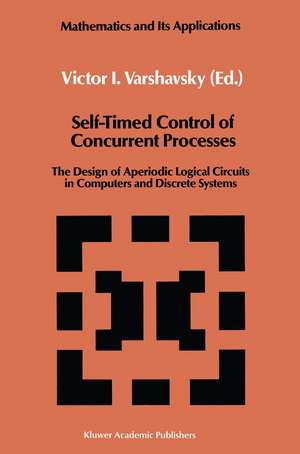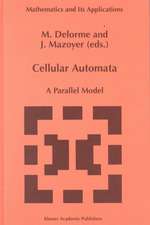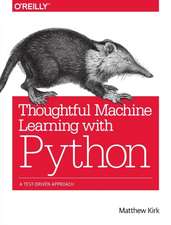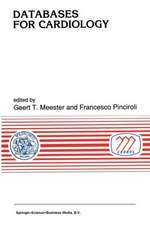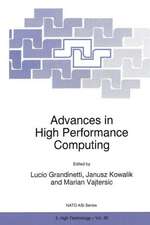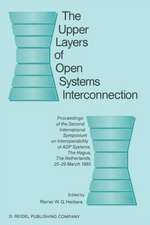Self-Timed Control of Concurrent Processes: The Design of Aperiodic Logical Circuits in Computers and Discrete Systems: Mathematics and its Applications, cartea 52
Editat de Victor I. Varshavskyen Limba Engleză Paperback – 2 oct 2011
Din seria Mathematics and its Applications
- 15%
 Preț: 499.42 lei
Preț: 499.42 lei -
 Preț: 367.83 lei
Preț: 367.83 lei -
 Preț: 480.62 lei
Preț: 480.62 lei -
 Preț: 381.89 lei
Preț: 381.89 lei -
 Preț: 483.29 lei
Preț: 483.29 lei -
 Preț: 435.39 lei
Preț: 435.39 lei - 20%
 Preț: 371.26 lei
Preț: 371.26 lei -
 Preț: 435.59 lei
Preț: 435.59 lei - 15%
 Preț: 433.37 lei
Preț: 433.37 lei - 15%
 Preț: 459.13 lei
Preț: 459.13 lei -
 Preț: 496.39 lei
Preț: 496.39 lei - 18%
 Preț: 1055.51 lei
Preț: 1055.51 lei -
 Preț: 432.50 lei
Preț: 432.50 lei -
 Preț: 427.71 lei
Preț: 427.71 lei -
 Preț: 483.99 lei
Preț: 483.99 lei -
 Preț: 356.64 lei
Preț: 356.64 lei - 15%
 Preț: 642.83 lei
Preț: 642.83 lei -
 Preț: 392.97 lei
Preț: 392.97 lei - 15%
 Preț: 651.67 lei
Preț: 651.67 lei - 15%
 Preț: 642.00 lei
Preț: 642.00 lei - 15%
 Preț: 647.59 lei
Preț: 647.59 lei -
 Preț: 389.49 lei
Preț: 389.49 lei -
 Preț: 394.12 lei
Preț: 394.12 lei - 15%
 Preț: 652.17 lei
Preț: 652.17 lei - 20%
 Preț: 651.57 lei
Preț: 651.57 lei - 15%
 Preț: 650.19 lei
Preț: 650.19 lei -
 Preț: 382.36 lei
Preț: 382.36 lei -
 Preț: 392.97 lei
Preț: 392.97 lei - 15%
 Preț: 657.39 lei
Preț: 657.39 lei - 15%
 Preț: 658.37 lei
Preț: 658.37 lei
Preț: 651.89 lei
Preț vechi: 814.86 lei
-20% Nou
Puncte Express: 978
Preț estimativ în valută:
124.75€ • 135.46$ • 104.79£
124.75€ • 135.46$ • 104.79£
Carte tipărită la comandă
Livrare economică 22 aprilie-06 mai
Preluare comenzi: 021 569.72.76
Specificații
ISBN-13: 9789401067058
ISBN-10: 9401067058
Pagini: 428
Ilustrații: 432 p.
Dimensiuni: 155 x 235 x 22 mm
Greutate: 0.59 kg
Ediția:Softcover reprint of the original 1st ed. 1990
Editura: SPRINGER NETHERLANDS
Colecția Springer
Seria Mathematics and its Applications
Locul publicării:Dordrecht, Netherlands
ISBN-10: 9401067058
Pagini: 428
Ilustrații: 432 p.
Dimensiuni: 155 x 235 x 22 mm
Greutate: 0.59 kg
Ediția:Softcover reprint of the original 1st ed. 1990
Editura: SPRINGER NETHERLANDS
Colecția Springer
Seria Mathematics and its Applications
Locul publicării:Dordrecht, Netherlands
Public țintă
ResearchCuprins
1 Introduction.- 2 Asynchronous processes and their interpretation.- 2.1 Asynchronous processes.- 2.2 Petri nets.- 2.3 Signal graphs.- 2.4 The Muller model.- 2.5 Parallel asynchronous flow charts.- 2.6 Asynchronous state machines.- 2.7 Reference notations.- 3 Self-synchronizing codes.- 3.1 Preliminary definitions.- 3.2 Direct-transition codes.- 3.3 Two-phase codes.- 3.4 Double-rail code.- 3.5 Code with identifier.- 3.6 Optimally balanced code.- 3.7 On the code redundancy.- 3.8 Differential encoding.- 3.9 Reference notations.- 4 Aperiodic circuits.- 4.1 Two-phase implementation of finite state machine.- 4.2 Completion indicators and checkers.- 4.3 Synthesis of combinatorial circuits.- 4.4 Aperiodic flip-flops.- 4.5 Canonical aperiodic implementations of finite state machines.- 4.6 Implementation with multiple phase signals.- 4.7 Implementation with direct transitions.- 4.8 On the definition of an aperiodic state machine.- 4.9 Reference notations.- 5 Circuit modelling of control flow.- 5.1 The modelling of Petri nets.- 5.2 The modelling of parallel asynchronous flow charts.- 5.3 Functional completeness and synthesis of semi-modular circuits.- 5.4 Synthesis of semi-modular circuits in limited bases.- 5.5 Modelling pipeline processes.- 5.6 Reference notations.- 6 Composition of asynchronous processes and circuits.- 6.1 Composition of asynchronous processes.- 6.2 Composition of aperiodic circuits.- 6.3 Algebra of asynchronous circuits.- 6.4 Reference notations.- 7 The matching of asynchronous processes and interface organization.- 7.1 Matched asynchronous processes.- 7.2 Protocol.- 7.3 The matching asynchronous process.- 7.4 The T2 interface.- 7.5 Asynchronous interface organization.- 7.6 Reference notations.- 8 Analysis of asynchronous circuits and processes.- 8.1 The reachability analysis.- 8.2 The classification analysis.- 8.3 The set of operational states.- 8.4 The effect of non-zero wire delays.- 8.5 Circuit Petri nets.- 8.6 On the complexity of analysis algorithms.- 8.7 Reference notations.- 9 Anomalous behaviour of logical circuits and the arbitration problem.- 9.1 Arbiters.- 9.2 Oscillatory anomaly.- 9.3 Meta-stability anomaly.- 9.4 Designing correctly-operating arbiters.- 9.5 “Bounded” arbiters and safe inertial delays.- 9.6 Reference notations.- 10 Fault diagnosis and self-repair in aperiodic circuits.- 10.1 Totally self-checking combinational circuits.- 10.2 Totally self-checking sequential machines.- 10.3 Fault detection in autonomous circuits.- 10.4 Self-repair organization for aperiodic circuits.- 10.5 Reference notations.- 11 Typical examples of aperiodic design modules.- 11.1 The JK-flip-flop.- 11.2 Registers.- 11.3 Pipeline registers.- 11.4 Converting single-rail signals into double-rail ones.- 11.5 Counters.- 11.6 Reference notations.- Editor’s Epilogue.- References.
